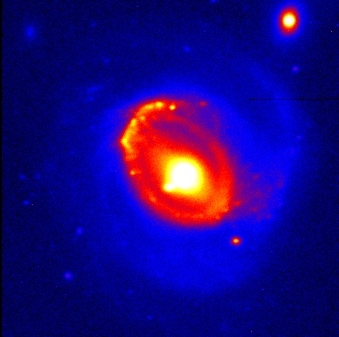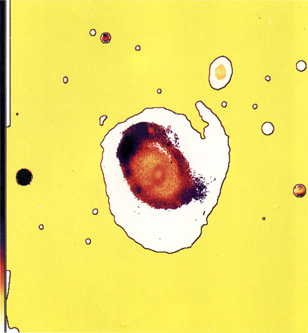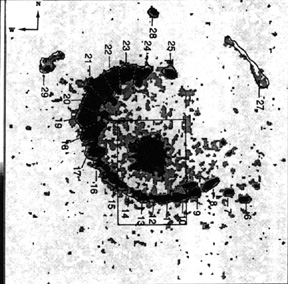


3.4. Star Formation Properties of Ring Galaxies
Shortly after the IRAS point source catalog became available it was
realized that ring galaxies emit a substantial amount of luminosity in
the far infrared
(Appleton and
Struck-Marcell 1987a).
Many ring galaxies are IRAS sources at
 100 µm and
more have been detected at
100 µm and
more have been detected at
 60 µm, a
result of the publication of the faint IRAS point
source catalog. Ring galaxies, like other collisional galaxy systems,
exhibit higher than normal 60/100 micron color temperatures and range
in far IR luminosity from 1010
L
60 µm, a
result of the publication of the faint IRAS point
source catalog. Ring galaxies, like other collisional galaxy systems,
exhibit higher than normal 60/100 micron color temperatures and range
in far IR luminosity from 1010
L to a few
× 1011
L
to a few
× 1011
L . It
was argued by
Appleton and Struck-Marcell that, in most cases, the bulk of the FIR
emission was from extended regions of star formation. A similar
conclusion was drawn independently by
Jeske (1986) and
Wakamatsu and Nishida
(1987).
. It
was argued by
Appleton and Struck-Marcell that, in most cases, the bulk of the FIR
emission was from extended regions of star formation. A similar
conclusion was drawn independently by
Jeske (1986) and
Wakamatsu and Nishida
(1987).
Until recently, very little systematic work has been done on the
star formation properties of ring galaxies. The first detailed study
of star formation in ring galaxies was made by
Fosbury and Hawarden
(1977),
and they showed that the Cartwheel ring contains large numbers
of O and B stars concentrated in bright knots around the ring. The
recent study of the Cartwheel by
Higdon (1993)
confirms these results,
considerably adding to our knowledge of the optical emission-line
properties of this galaxy. These results will soon be published
(Higdon, in preparation). Higdon found that the total energy output
of the Cartwheel in the H line was a factor of 10 times larger than
that of the most luminous normal late-type spiral studied by
Kennicutt (1988).
An interesting result of Higdon's study was the discovery that
80% of the H
line was a factor of 10 times larger than
that of the most luminous normal late-type spiral studied by
Kennicutt (1988).
An interesting result of Higdon's study was the discovery that
80% of the H emission
from the Cartwheel comes from just one
quadrant of the outer ring, the rest coming almost exclusively from the
other three quadrants of the outer ring. Like Fosbury and Hawarden before
him, Higdon did not detect
H
emission
from the Cartwheel comes from just one
quadrant of the outer ring, the rest coming almost exclusively from the
other three quadrants of the outer ring. Like Fosbury and Hawarden before
him, Higdon did not detect
H emission from the
inner ring, despite
predictions from numerical models that the inner ring should contain
highly compressed gas
(Appleton and
Struck-Marcell 1987b;
Hernquist and Weil
1993).
In addition, 15% of the line emission was found to
lie in a diffuse component associated with the ring, but not directly
attributed to discrete star formation knots.
emission from the
inner ring, despite
predictions from numerical models that the inner ring should contain
highly compressed gas
(Appleton and
Struck-Marcell 1987b;
Hernquist and Weil
1993).
In addition, 15% of the line emission was found to
lie in a diffuse component associated with the ring, but not directly
attributed to discrete star formation knots.
The brightest HII region complexes in the Cartwheel have
H luminosities in excess of 1041 ergs cm-2
s-1, which is at the extreme
end of the luminosity function for HII regions in late-type spirals.
Higdon found that the total (instantaneous) star formation rate from
the galaxy is currently 67.5
M
luminosities in excess of 1041 ergs cm-2
s-1, which is at the extreme
end of the luminosity function for HII regions in late-type spirals.
Higdon found that the total (instantaneous) star formation rate from
the galaxy is currently 67.5
M yr-1 (assuming a Miller-Scalo
IMF). This is 9.1 times the star formation rate estimated from the
B-band luminosity which is sensitive to the integrated star formation
rate over the last 15 Gyrs. Given the HI Mass (1.3 ×
1010
M
yr-1 (assuming a Miller-Scalo
IMF). This is 9.1 times the star formation rate estimated from the
B-band luminosity which is sensitive to the integrated star formation
rate over the last 15 Gyrs. Given the HI Mass (1.3 ×
1010
M )
distributed in the ring galaxy, Higdon found that the gas consumption
timescale was 430 Myrs, a timescale similar to the ring propagation
timescale.
)
distributed in the ring galaxy, Higdon found that the gas consumption
timescale was 430 Myrs, a timescale similar to the ring propagation
timescale.
Marston and Appleton
(1995)
have investigated the distribution and
strength of star formation in a larger sample of northern ring
galaxies via H imaging. Except for the case of WN1
(Wakamatsu and Nishida
1987),
a Seyfert galaxy,
H
imaging. Except for the case of WN1
(Wakamatsu and Nishida
1987),
a Seyfert galaxy,
H emission is found
exclusively in
the rings and not interior to them, or within the nucleus. In all
cases, a large fraction of the star formation appeared to originate in
discrete knots. Like the Cartwheel, a large number of the galaxies
studied showed significant azimuthal variation in the
H
emission is found
exclusively in
the rings and not interior to them, or within the nucleus. In all
cases, a large fraction of the star formation appeared to originate in
discrete knots. Like the Cartwheel, a large number of the galaxies
studied showed significant azimuthal variation in the
H distributions
around the ring, often exhibiting major concentrations of star
formation in certain regions of the ring. Also, like the Cartwheel, a
faint but significant component of
H
distributions
around the ring, often exhibiting major concentrations of star
formation in certain regions of the ring. Also, like the Cartwheel, a
faint but significant component of
H emission was detected
from a diffuse component upon which the brighter knots are superimposed. In
all cases studied, the diffuse component formed a complete ring,
whereas in many cases the bright knots of star formation are
concentrated in one quadrant of the ring. Until higher spatial
resolution is obtained (via upcoming Hubble Space Telescope
observations) it is impossible to determine whether the diffuse
H
emission was detected
from a diffuse component upon which the brighter knots are superimposed. In
all cases studied, the diffuse component formed a complete ring,
whereas in many cases the bright knots of star formation are
concentrated in one quadrant of the ring. Until higher spatial
resolution is obtained (via upcoming Hubble Space Telescope
observations) it is impossible to determine whether the diffuse
H represents a different mode of star formation from the bright knots,
or whether the bright knots represent stochastic regions of
significantly enhanced star formation in the general background of
lower-level star formation in the ring.
represents a different mode of star formation from the bright knots,
or whether the bright knots represent stochastic regions of
significantly enhanced star formation in the general background of
lower-level star formation in the ring.
In an effort to understand the marked azimuthal asymmetries in the
star formation regions in ring galaxies,
Charmandaris, Appleton
and Marston (1993),
made a detailed study of Arp 10, (Figure 13a) which
appeared to show a particularly striking example of a non-uniform
ring. Figure 13b shows the
H distribution in the
galaxy. Like the Cartwheel, this galaxy shows a strong enhancement of
H
distribution in the
galaxy. Like the Cartwheel, this galaxy shows a strong enhancement of
H flux in one
quadrant of the ring. Such global enhancements in star formation rates
were predicted in the models of
Appleton and
Struck-Marcell (1987b)
if the star formation rate had a threshold dependence on ring
over-density.
Charmandaris, Appleton
and Marston (1993)
were able to
show that the star formation rate in the ring jumped suddenly from a
low value to a high value in the relatively smooth underlying stellar
ring, implying some form of "threshold" process was at work
controlling the star formation rates. Observations of the cold gas
phase in these galaxies will be needed to confirm these intriguing
results.
flux in one
quadrant of the ring. Such global enhancements in star formation rates
were predicted in the models of
Appleton and
Struck-Marcell (1987b)
if the star formation rate had a threshold dependence on ring
over-density.
Charmandaris, Appleton
and Marston (1993)
were able to
show that the star formation rate in the ring jumped suddenly from a
low value to a high value in the relatively smooth underlying stellar
ring, implying some form of "threshold" process was at work
controlling the star formation rates. Observations of the cold gas
phase in these galaxies will be needed to confirm these intriguing
results.

|

|

|
Figure 13. a) The RN ring galaxy Arp 10
(B-band from
Appleton and Marston
1995;
KPNO 2.1m telescope) exhibits extremely strong blue
emission from one quadrant of the ring. b) B-R color map of Arp 10. Note the extremely blue quadrant of the ring
and the color
gradient inside the ring. Color coding is similar to that of Figures
7a and 7b. c) The H |
Whatever the detailed cause of the azimuthal variations in star formation rates, it is clear that something is regulating the global star formation rates in the rings. Only the most circular rings(e.g. VIIZw466) show a uniform smattering of bright knots around the ring. In most cases, the bright knots are concentrated in one or two major complexes. It is very likely that the appearance of enhancements in star formation relates to the underlying asymmetry of the off-center collision. The distribution of these "hot-spots" may also relate to the position of shocks in three dimensions (Gerber et al. 1994).
One of the remarkable recent numerical results which deserves some comment is that of the different behavior of gas and stars in the SPH models of Gerber (1994). This work has shown that depending on the strength of the perturbation, the gas ring will either lead or trail the stellar ring. In the case of strong perturbations (for example, massive intruders), the gas ring is so dissipative that it lags significantly behind the stellar density wave. In the case of a small perturbation, the gas tends to pile up on the front-edge of the wave, where gas clouds first cross one another (Gerber, personal communication). Such model predictions are of great importance since they illustrate the remarkable usefulness of the ring galaxy as a "cosmic experiment". For example, the fact that star formation is found exclusively on the leading edge of the underlying infrared wave in the recent study of ring galaxies by Marston and Appleton (1995) (see also Appleton, Schombert and Robson 1992) suggests that the ionized gas component leads any underlying density wave. If correct (we don't yet have information on the cool gas) this implies that either most ring-making collisions involve small perturbations, or that the K-band light does not represent a stellar density wave. If the former explanation is correct, then this must imply that many ring galaxy targets have extremely large massive halos, since many of the companions are quite luminous and would be expected to lead to a large rather than small perturbation of the target disk. Further work is clearly needed in this interesting area.